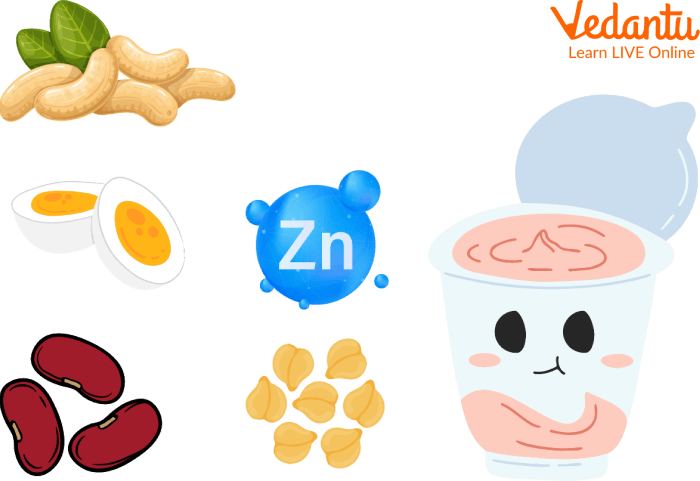




Timeline, Key Discoveries & Uses of Zinc in Science
A metallic element with a bright bluish-white hue is zinc. It ranks 24th among the most prevalent elements in the earth's crust and has an atomic number of 30. The periodic table's 12th group of transition metals is where zinc is located. It possesses 2 electrons in its valence shell and 34 neutrons in its most common isotope.
In this article, we will discuss when zinc was discovered, the characteristics and properties of zinc, and the uses of zinc too. So now let us move on to the detailed study of zinc. We will also discuss the facts about zinc.

Symbol of Zinc
Characteristics of Zinc
Zinc is a mildly reactive element; when exposed to air, its surface turns a dull white tint. It is a bad metal for moulding and is slightly fragile at room temperature. But it becomes more malleable and straightforward to shape when heated to a temperature of 100 degrees Celsius.
Properties of Zinc
In comparison to most metals, zinc has relatively low melting and boiling points. Ancient people found it challenging to isolate it in elemental form by heating its minerals because of its low boiling point. Compared to most metals, zinc has a relatively high electrical conductivity.
Some properties of zinc include the following:
Bluish-white in colour
Corrosion resistant
A little fragile
Good electrical and thermal conductor
Moderately reactive
Strong reducing agent
Uses of Zinc
In comparison to most metals, zinc is an excellent corrosion-resistant metal that is also affordable. Due to this, most of the zinc produced today is used to galvanise or coat other metals like iron to prevent corrosion.
Ancient people employed zinc to create a variety of alloys with other metals, including brass. At present, it is also utilised to create alloys to create metals with the necessary qualities. Zinc found in food must be consumed to sustain the levels already present in the human body. Additionally, it is utilised in sunblock creams, multivitamin pills, and nutritional supplements.

Sources of Zinc From Food
Where is Zinc Found?
After iron, aluminium, and copper, zinc is currently the fourth most used metal worldwide. Zinc is a common element in numerous minerals found worldwide; however, it is rarely encountered in its basic form. The earth's oceans also contain trace amounts of dissolved zinc compounds.
Zinc can be extracted from a variety of minerals, although the most cost-effective minerals are smithsonite, sphalerite, wurtzite, and hemimorphite. Sphalerite, which yields zinc most profitably, is among them and is the mineral that is most readily available and mined. Numerous nations produce zinc, but China, Australia, and Peru are the three biggest producers.
Facts about Zinc
The alchemist Paracelsus is credited with giving zinc its name, which is derived from the German word "Zinke," which means "prong, teeth."
The following are some interesting facts about zinc:
Zinc produces zinc oxide and a bluish-green flame when it burns in oxygen gas.
2 to 4 grams of zinc can be found in the body of an adult.
Prestel is a zinc and aluminium alloy that functions like plastic but has steel-like strength.
Discovery of Zinc
Although civilization has long known about zinc, the latest archaeological evidence indicates that metallurgists may have made the first discovery of zinc before 1000 BCE. When producing brass, an alloy of copper and zinc, ancient people found zinc to be a particularly valuable metal. Although zinc is a component of brass, it was not kept in isolation in its purest form. Brass was traditionally produced by heating copper, charcoal, and calamine (a zinc mineral).
The zinc minerals have to be heated to more than a thousand degrees Celsius, which is over zinc's boiling point, to isolate the metal. Zinc was not removed at this high temperature; rather, it was cooked into fumes. Andreas Sigismund Marggraf separated zinc for the first time in its elemental form in 1746.
Summary
Zinc is a metallic chemical element with the atomic number 30 and the symbol Zn. Zinc is a blue-white metal that can be brittle or ductile depending on purity. With copper, it creates brass as well as numerous other alloys. Galvanising iron, steel, and other metals is its main application. Zinc is a crucial trace element, especially for red blood cells; in snails, it is analogous to iron in vertebrate blood. We hope this article will give you better knowledge about zinc.
FAQs on When Was Zinc Discovered?
1. Is taking zinc every day a wise idea?
Zinc is a necessary mineral important for many aspects of your health. A daily supplement of 15-30 mg of elemental zinc may help with blood sugar control, immunity, and the health of the eyes, heart, and skin. Supplemental zinc is frequently used to treat and prevent zinc insufficiency.
2. How can zinc insufficiency be avoided?
There are different methods one can prepare and consume food to increase the amount of zinc in their regular meals.
For instance, before cooking beans, they can be soaked in water. Lowering the amount of phytates present facilitates the body's absorption of zinc. Selecting leavened grain products can also aid in lowering phytate levels and raising the amount of zinc that the body can utilise.
You can lessen your risk of zinc insufficiency by eating a balanced, healthy diet that includes foods high in zinc, such as protein-rich meals like beans, red meat (beef and lamb), and peanuts.
3. How is zinc important for our body?
Each cell in the body has zinc. It supports the immune system's defence against invasive viruses and bacteria. Additionally, the body needs zinc to produce DNA, and defend the genetic material found in every cell, and protein.
4. What are the best zinc-containing sources?
Oysters are the best source of zinc, but it is also abundant in red meat and fowl. Beans, almonds, crab, lobster, whole grains, breakfast cereals, and dairy products are additional excellent sources. Avocados, blackberries, pomegranates, raspberries, guavas, cantaloupes, apricots, peaches, kiwifruit, and blueberries are some fruits that are high in zinc. Per cup, these fruits offer 2-12% of the recommended daily intake.





















